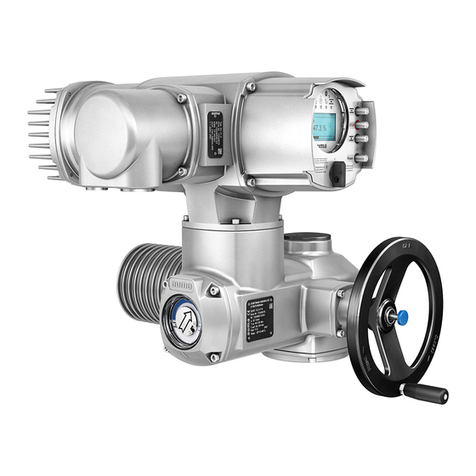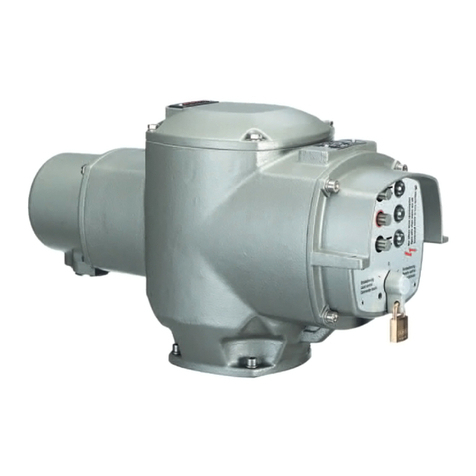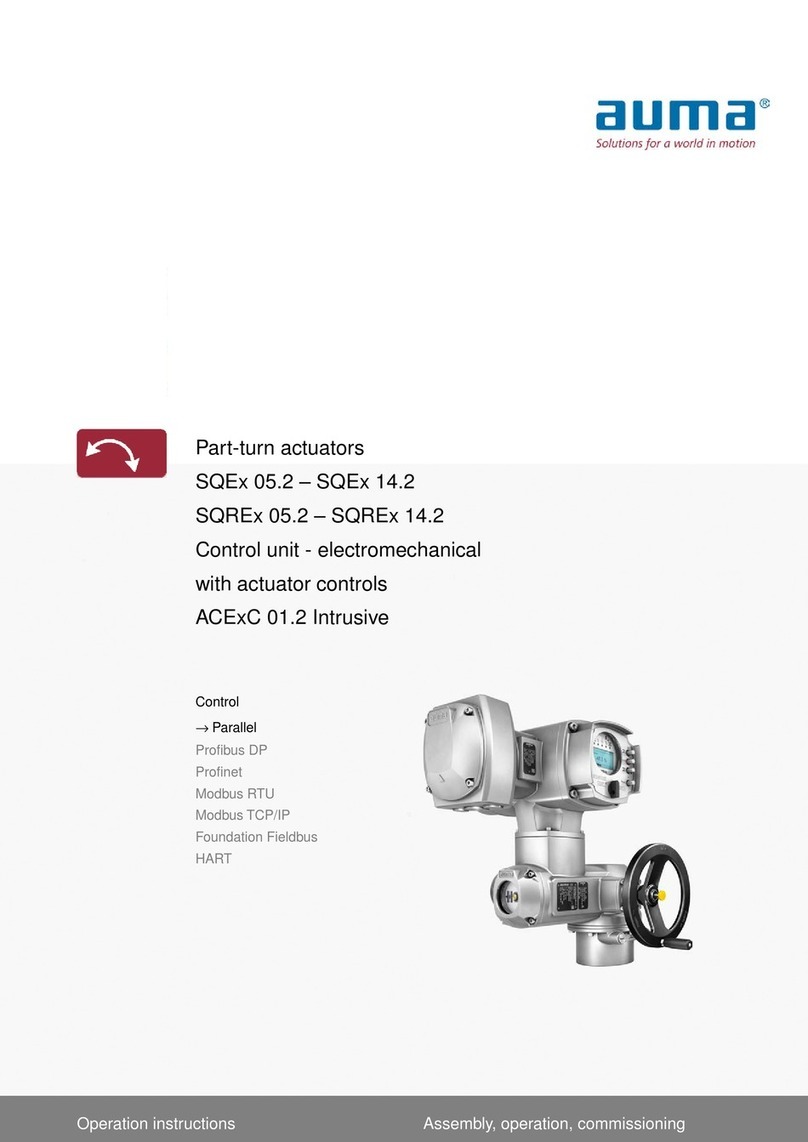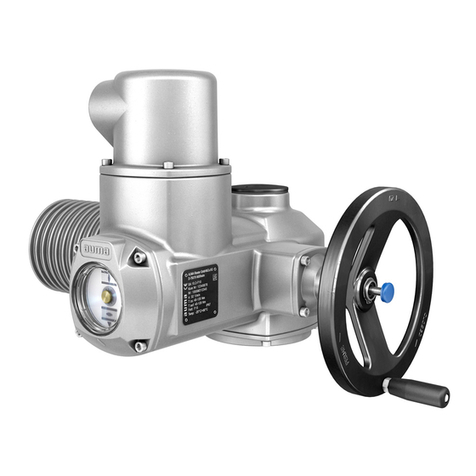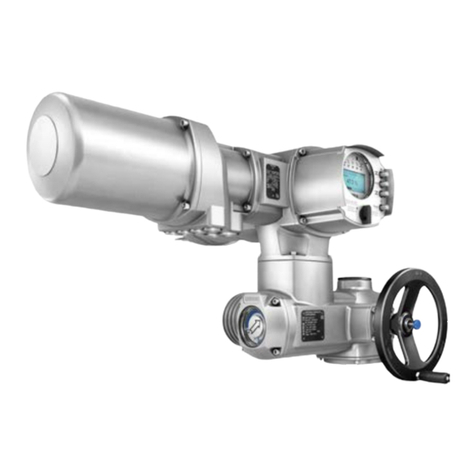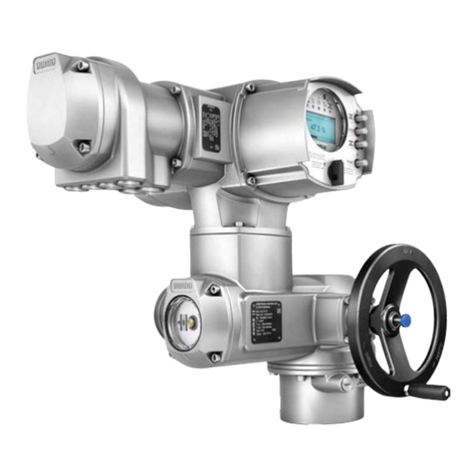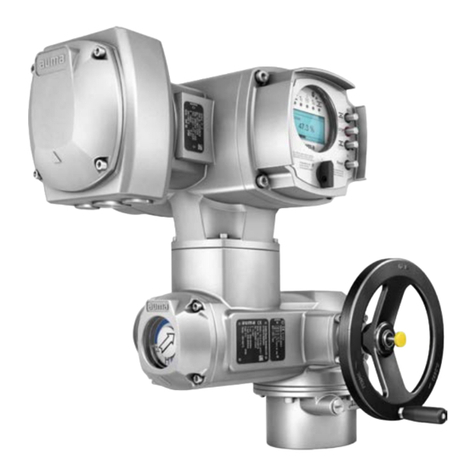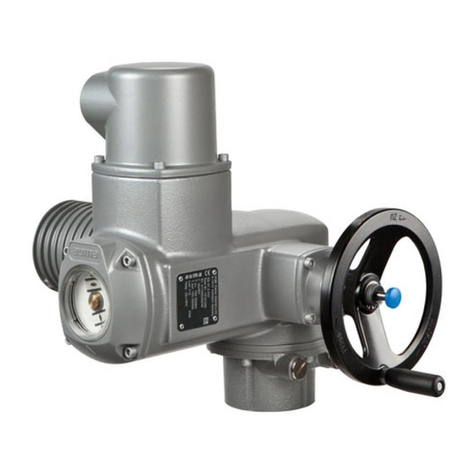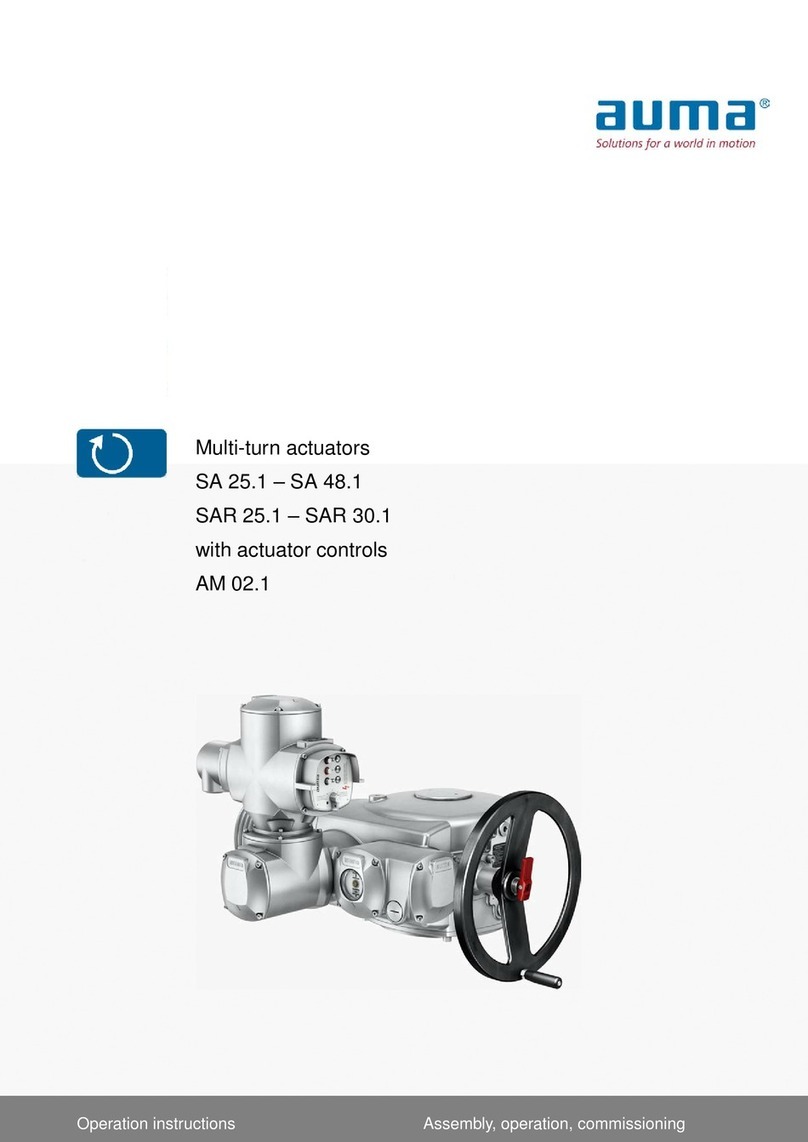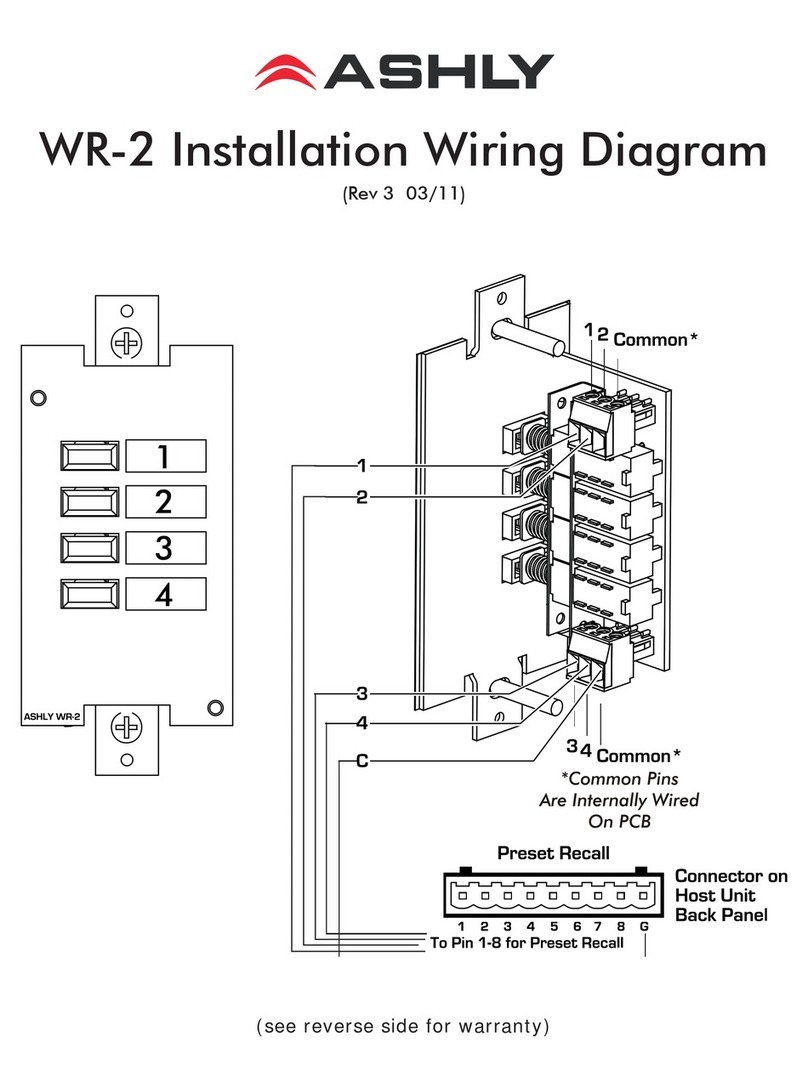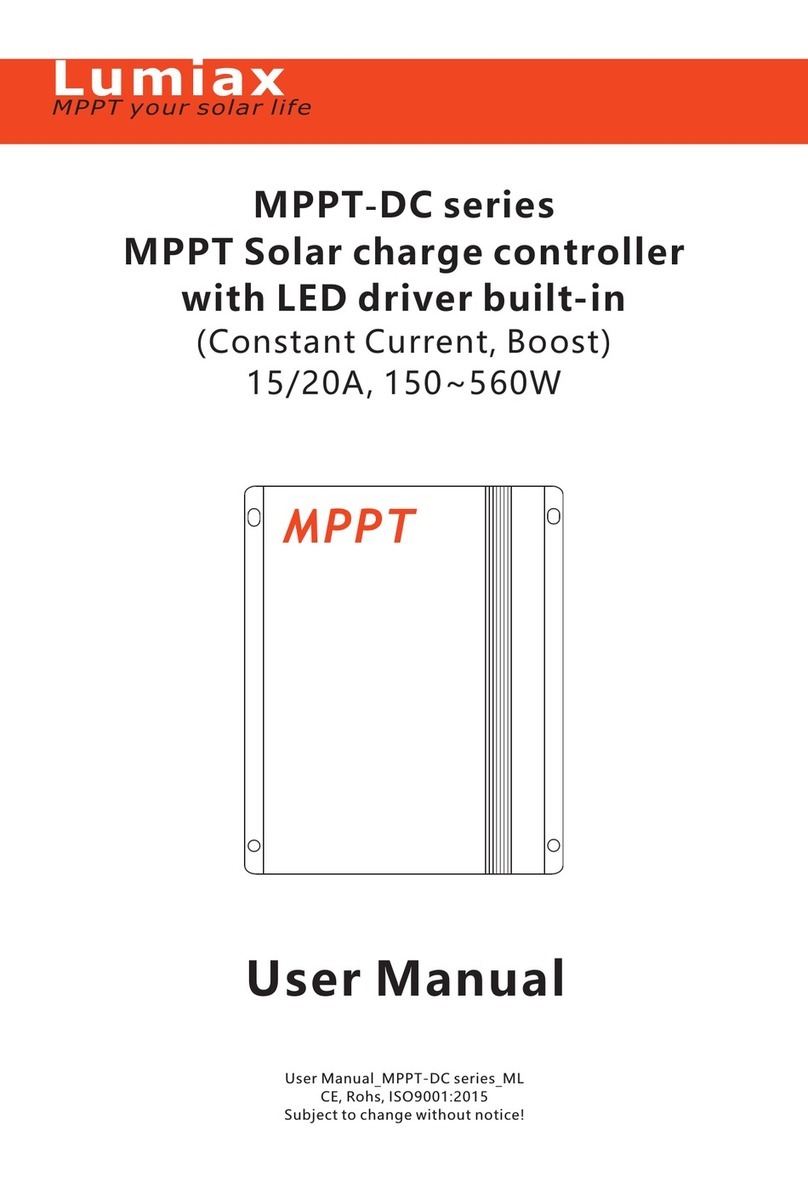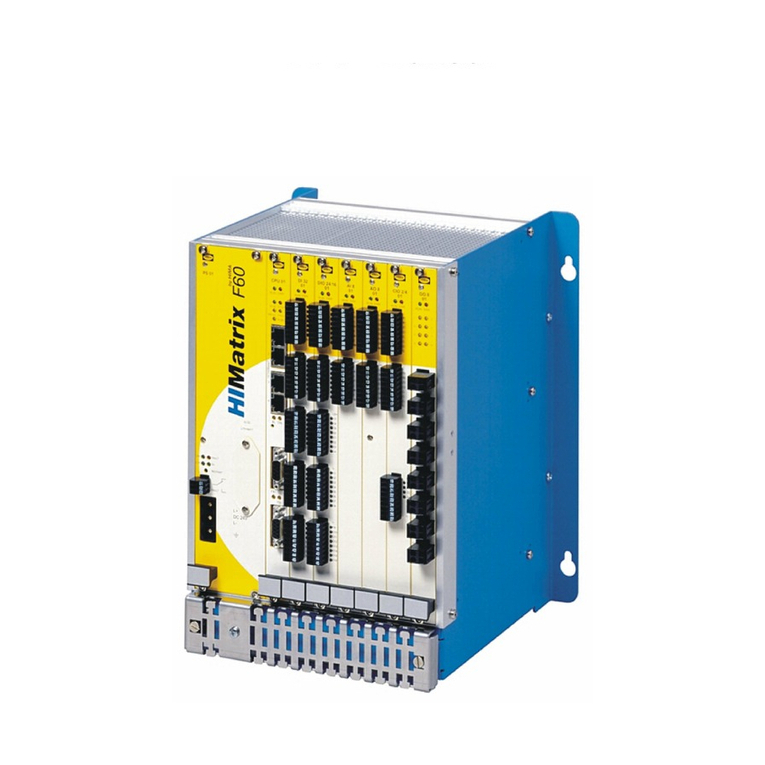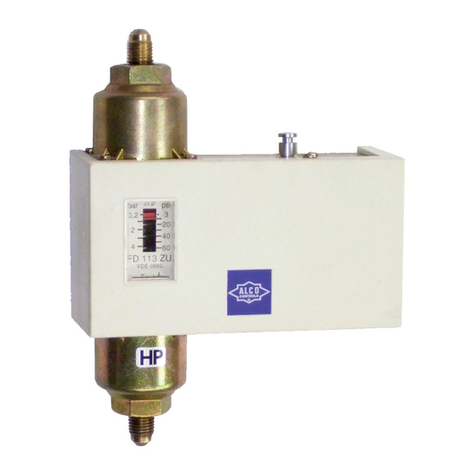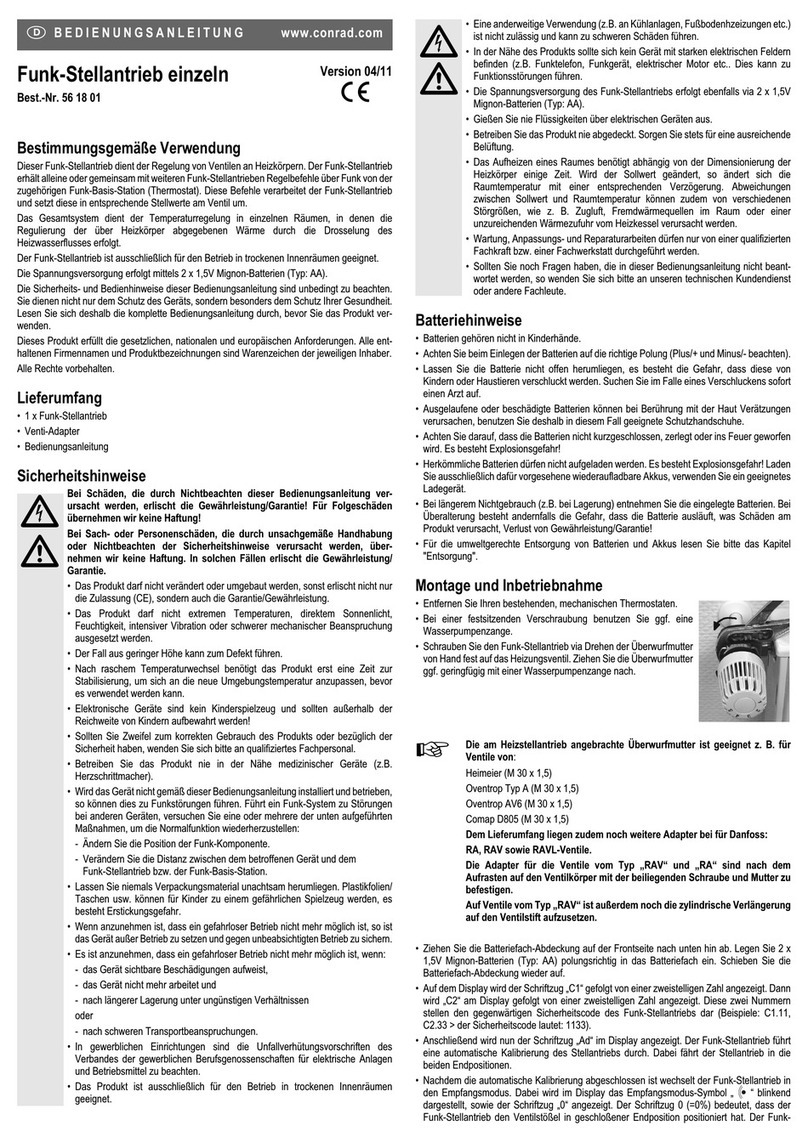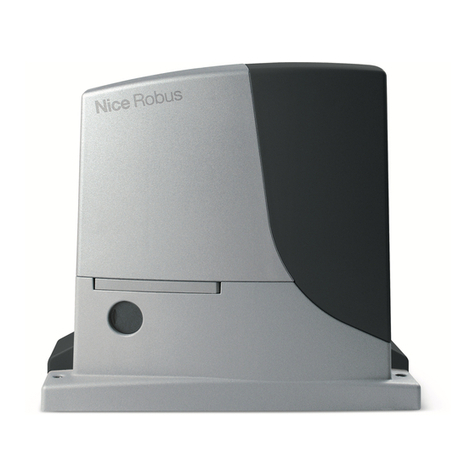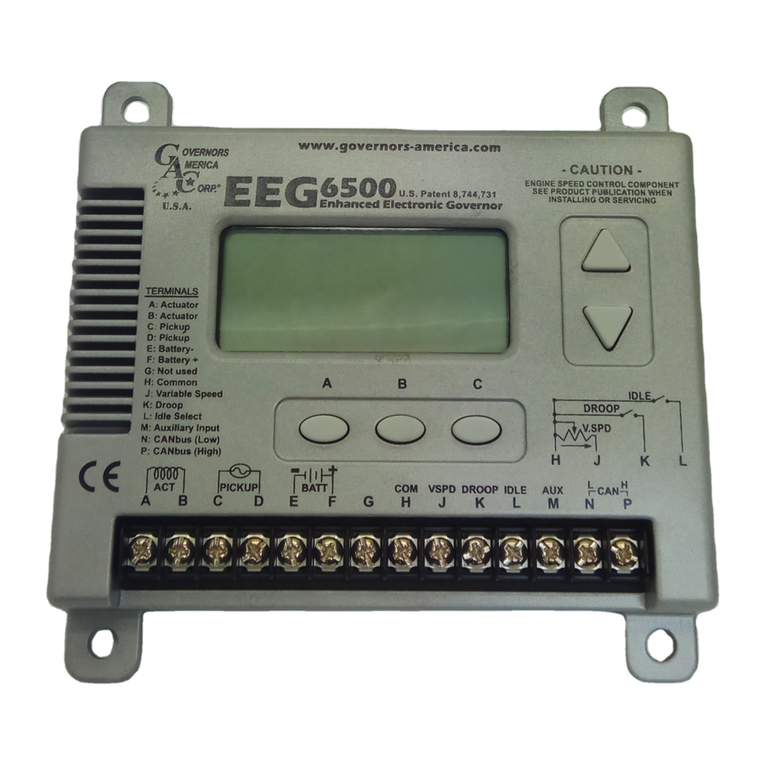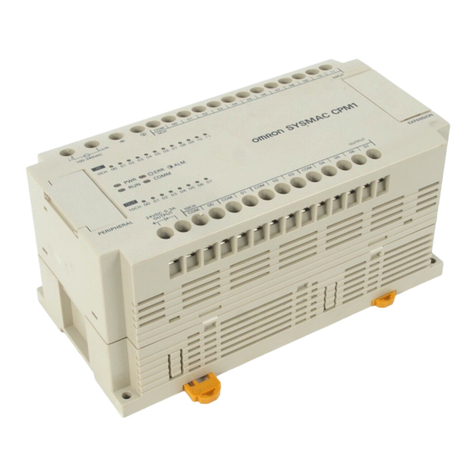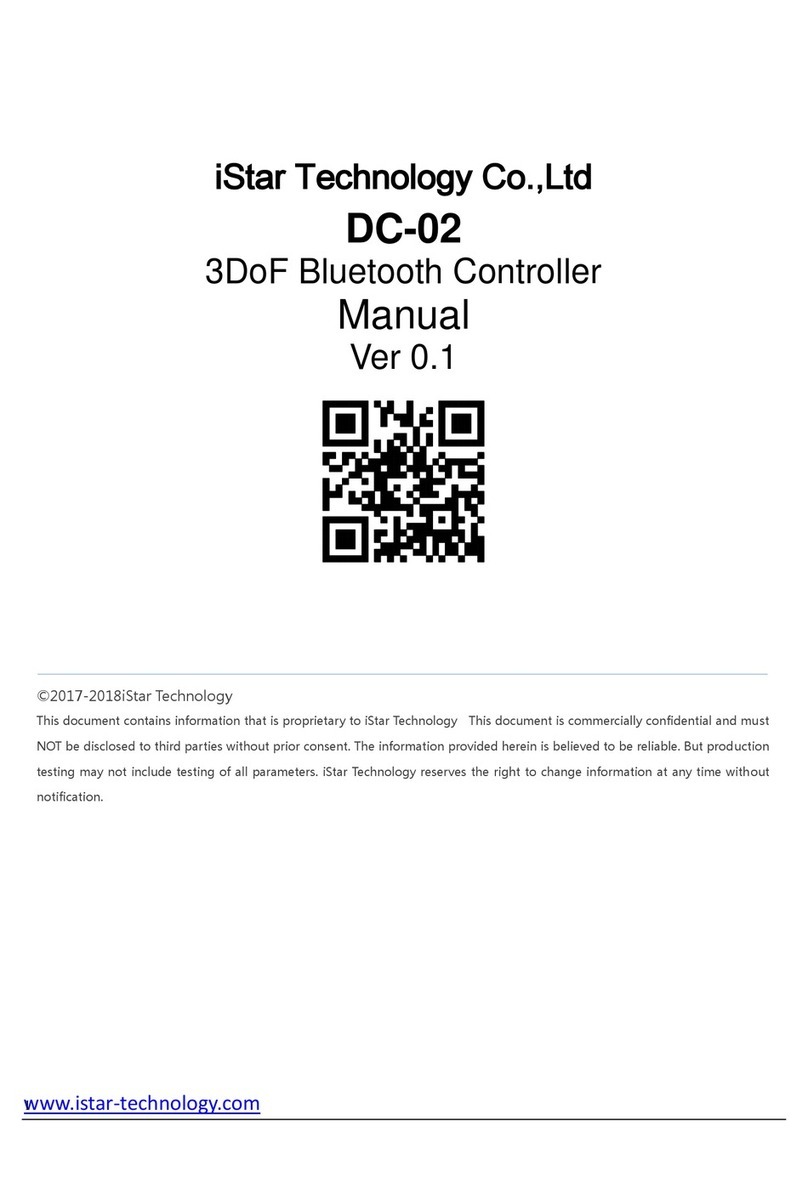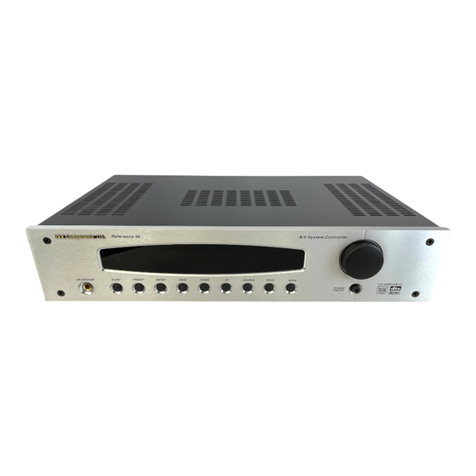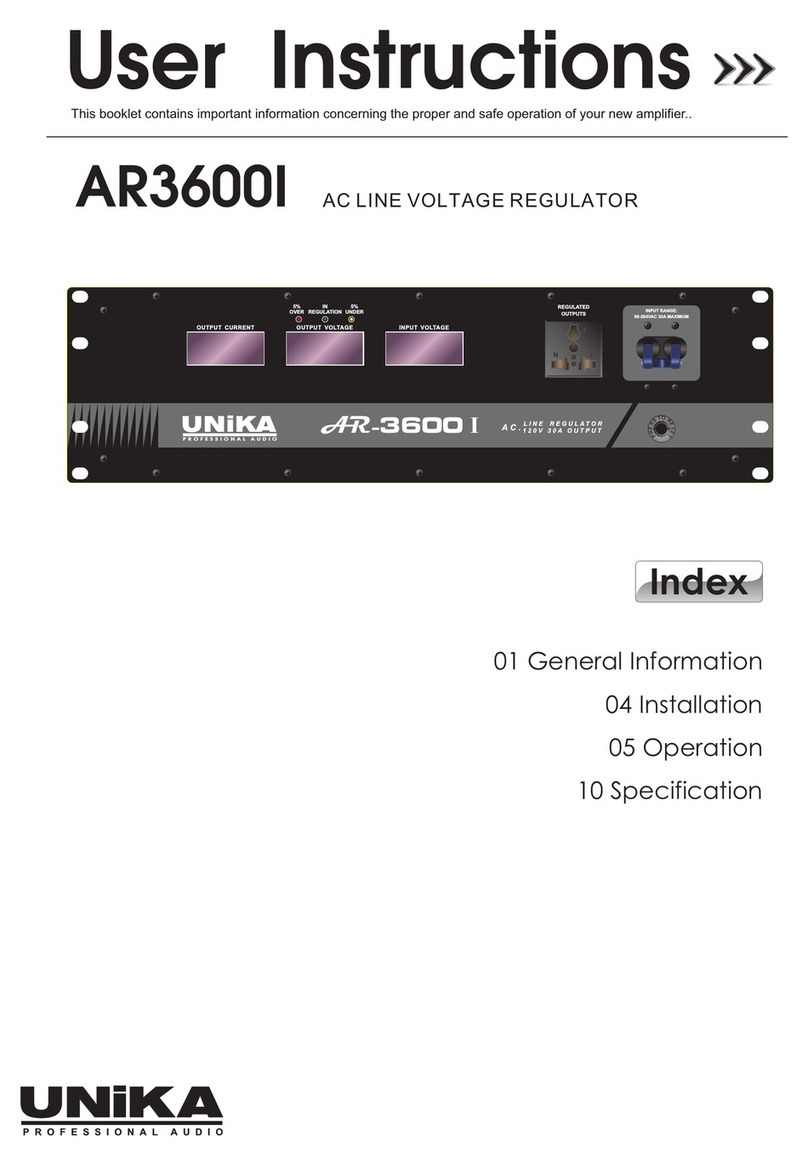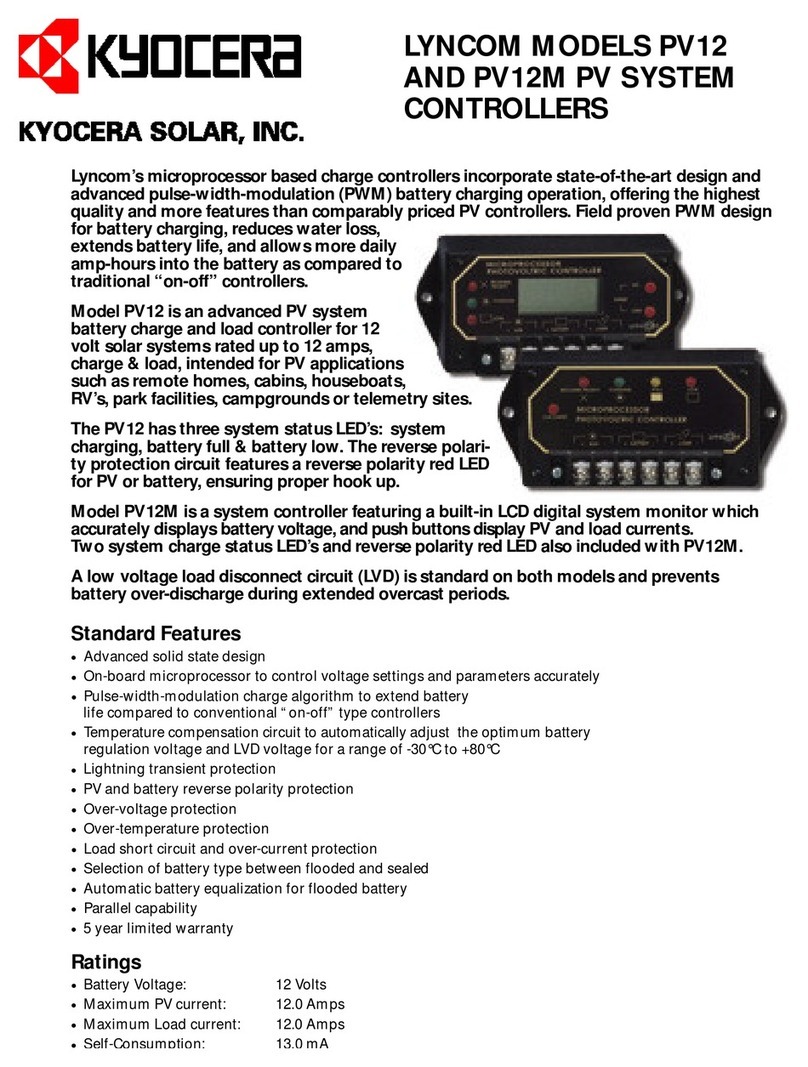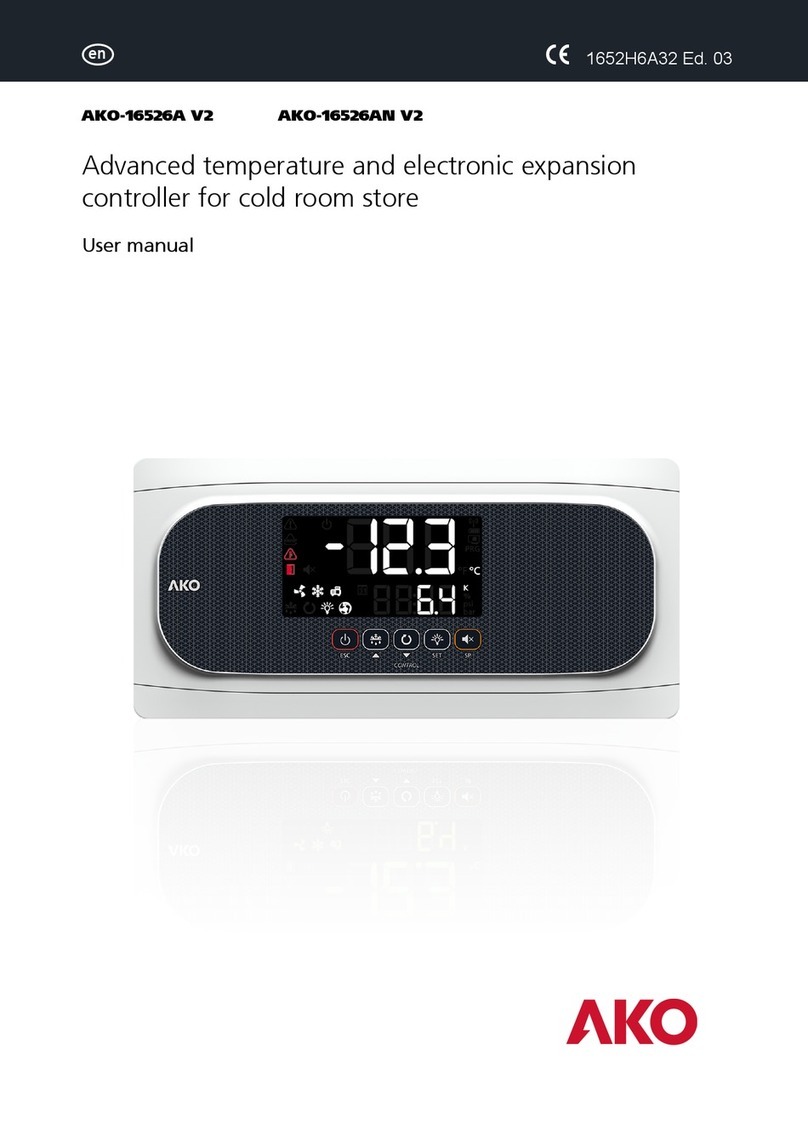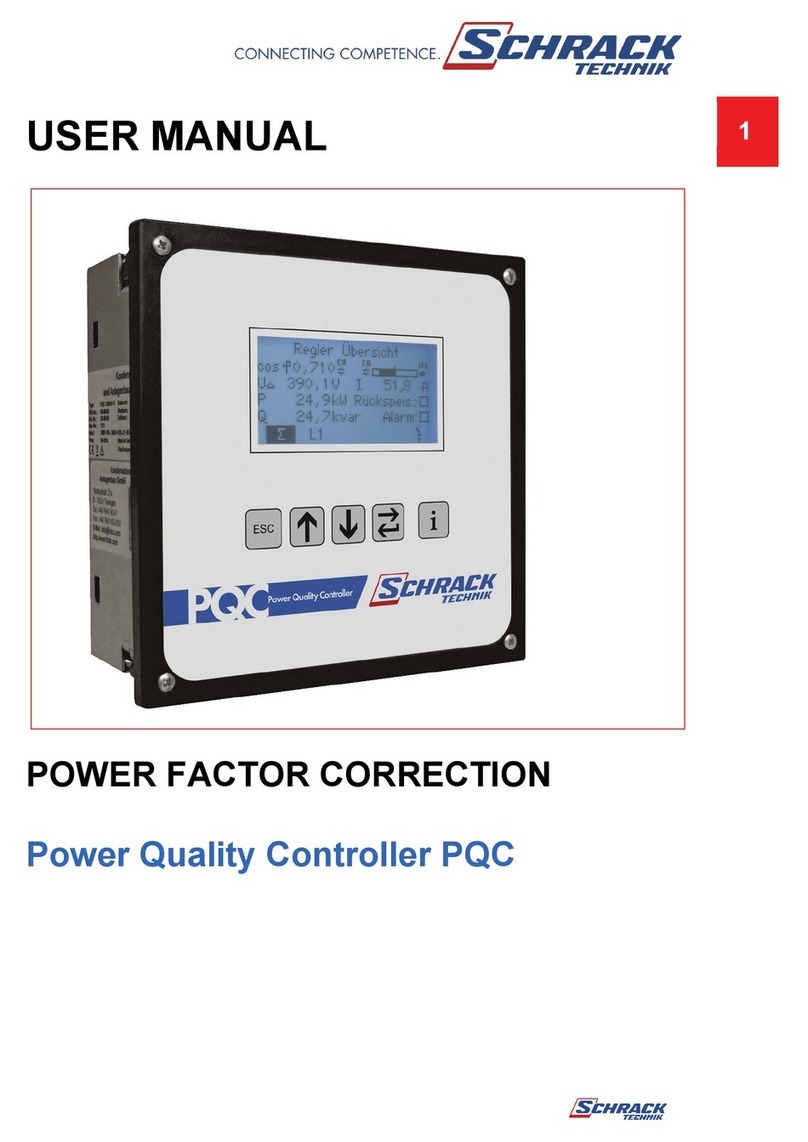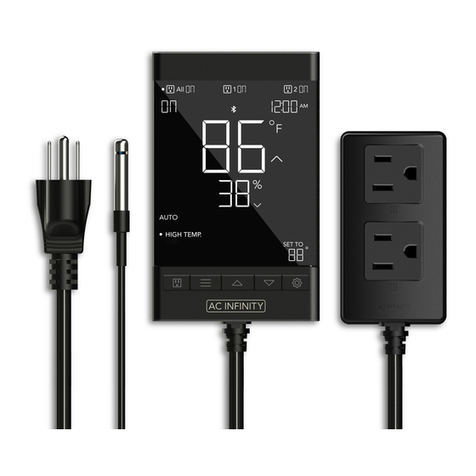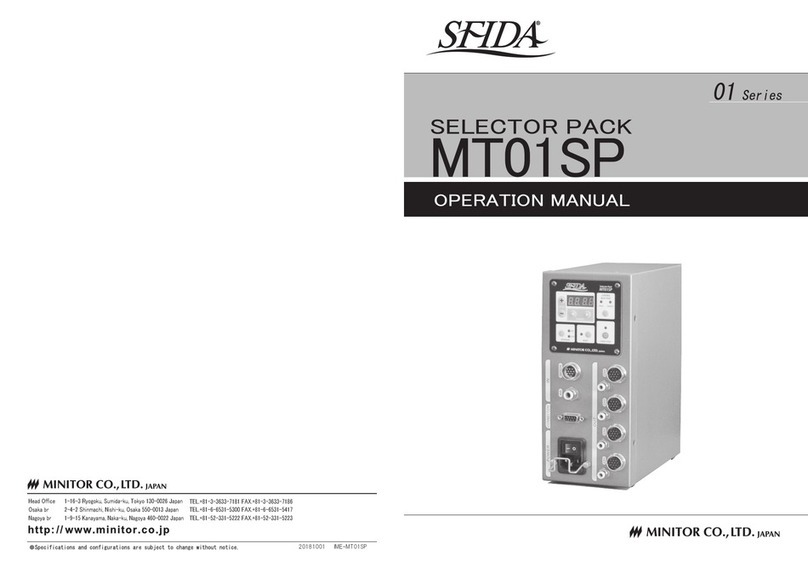AUMA SAI 07.2 User manual

Multi-turn actuators
SAI 07.2 –SAI 16.2
SARI 07.2 –SARI 16.2
AUMA NORM (without controls)
for use in nuclear power plants
Assembly, operation, commissioningOperation instructions

Read operation instructions first.
●Observe safety instructions.
●These operation instructions are part of the product.
●Retain operation instructions during product life.
●Pass on instructions to any subsequent user or owner of the product.
Purpose of the document:
This document contains information for installation, commissioning, operation and maintenance staff.It is intended
to support device installation and commissioning.
Table of contents Page
41. Safety instructions................................................................................................................. 41.1. Basic information on safety 41.2. Range of application 51.3. Warnings and notes 51.4. References and symbols
72. Identification........................................................................................................................... 72.1. Name plate 82.2. Short description
93. Transport, storage and packaging........................................................................................ 93.1. Transport 103.2. Storage 103.3. Packaging
114. Assembly................................................................................................................................ 114.1. Mounting position 114.2. Handwheel fitting 124.3. Multi-turn actuator: mount to valve/gearbox 124.3.1. Output drive type A 134.3.1.1. Stem nut: finish machining 144.3.1.2. Multi-turn actuator (with output drive type A):mount to valve 154.3.2. Output drive types B 164.3.2.1. Multi-turn actuator with output drive types B:mount to valve/gearbox 174.4. Accessories for assembly 174.4.1. Stem protection tube for rising valve stem
185. Electrical connection............................................................................................................. 185.1. Basic information 195.2. SH/SB electrical connection (AUMA plug/socket connector) 205.2.1. Terminal compartment : open 215.2.2. Cable connection 235.2.3. Terminal compartment : close 245.3. Accessories for electrical connection 245.3.1. Parking frame 245.3.2. External earth connection
256. Operation................................................................................................................................ 256.1. Manual operation 256.1.1. Engage manual operation 256.1.2. Manual operation: disengage
2
SAI 07.2 –SAI 16.2 / SARI 07.2 –SARI 16.2
Table of contents for use in nuclear power plants

256.2. Motor operation
267. Indications (optional)............................................................................................................. 267.1. Mechanical position indication/running indication via indicator mark on cover
278. Signals (output signals)......................................................................................................... 278.1. Feedback signals from actuator
289. Commissioning (basic settings)........................................................................................... 289.1. Switch compartment: open 289.2. Torque switching: set 299.3. Limit switching: set 299.3.1. End position CLOSED (black section): set 309.3.2. End position OPEN (white section): set 309.4. Test run 309.4.1. Direction of rotation: check 319.4.2. Limit switching: check 329.5. Switch compartment: close
3310. Commissioning (optional equipment settings)................................................................... 3310.1. Potentiometer 3310.1.1. Potentiometer: set 3310.2. Intermediate positions: set 3410.2.1. Running direction CLOSE (black section): set 3410.2.2. Running direction OPEN (white section): set 3510.3. Mechanical position indicator: set
3611. Corrective action.................................................................................................................... 3611.1. Faults during commissioning 3611.2. Motor protection (thermal monitoring)
3712. Servicing and maintenance................................................................................................... 3712.1. Preventive measures for servicing and safe operation 3712.2. Maintenance 3812.3. Disposal and recycling
3913. Technical data......................................................................................................................... 3913.1. Technical data Multi-turn actuators
4214. Spare parts............................................................................................................................. 4214.1. Multi-turn actuators SAI 07.2 –SAI 16.2/SARI 07.2 –SARI 16.2
4415. Certificates.............................................................................................................................. 4415.1. Declaration of Incorporation and EC Declaration of Conformity
47Index........................................................................................................................................
49Addresses...............................................................................................................................
3
SAI 07.2 –SAI 16.2 / SARI 07.2 –SARI 16.2
for use in nuclear power plants Table of contents

1. Safety instructions
1.1. Basic information on safety
Standards/directives Our products are designed and manufactured in compliance with recognised
standards and directives.This is certified in a Declaration of Incorporation and an
EU Declaration of Conformity.
The end user or the contractor must ensure that all legal requirements, directives,
guidelines, national regulations and recommendations with respect to assembly,
electrical connection, commissioning and operation are met at the place of installation.
They include among others standards, directives on operation in nuclear power
plants and regulations on radiation protection in nuclear power plants.
Safetyinstructions/warn-
ings All personnel working with this device must be familiar with the safety and warning
instructions in this manual and observe the instructions given. Safety instructions
and warning signs on the device must be observed to avoid personal injury or property
damage.
Qualification of staff Assembly, electrical connection, commissioning, operation, and maintenance must
be carried out by suitably qualified personnel authorised by the end user or contractor
of the plant only.
Prior to working on this product, the staff must have thoroughly read and understood
these instructions and, furthermore, know and observe officially recognised rules
regarding occupational health and safety.
Work performed in radiation exposed areas is subject to special regulations which
have to be observed.The end user or contractor of the plant are responsible for
respect and control of these regulations, standards, and laws.
Commissioning Prior to commissioning, it is important to check that all settings meet the requirements
of the application. Incorrect settings might present a danger to the application, e.g.
cause damage to the valve or the installation.The manufacturer will not be held
liable for any consequential damage. Such risk lies entirely with the user.
Operation Prerequisites for safe and smooth operation:
●Correct transport, proper storage, mounting and installation, as well as careful
commissioning.
●Only operate the device if it is in perfect condition while observing these instruc-
tions.
●Immediately report any faults and damage and allow for corrective measures.
●Observe recognised rules for occupational health and safety.
●Observe national regulations.
●During operation,the housing warms upandsurfacetemperatures >60°C may
occur.To prevent possible burns, we recommend checking the surface temper-
ature using an appropriate thermometer and wearing protective gloves, if re-
quired, prior to working on the device.
Protective measures The end user or the contractor are responsible for implementing required protective
measures on site, such as enclosures, barriers, or personal protective equipment
for the staff.
Maintenance To ensure safe device operation, the maintenance instructions included in this manual
must be observed.
Any device modification requires prior written consent of the manufacturer.
1.2. Range of application
AUMA multi-turn actuators are designed for the operation of industrial valves, e.g.
globe valves, gate valves, butterfly valves, and ball valves.
The actuators are qualified for use in nuclear power plants and for DBE conditions
inside and outside containment.
4
SAI 07.2 –SAI 16.2 / SARI 07.2 –SARI 16.2
Safety instructions for use in nuclear power plants

Other applications require explicit (written) confirmation by the manufacturer.
The following applications are not permitted, e.g.:
●Industrial trucks according to EN ISO 3691
●Lifting appliances according to EN 14502
●Passenger lifts according to DIN 15306 and 15309
●Service lifts according to EN 81-1/A1
●Escalators
●Continuous duty
●Buried service
●Continuous submersion (observe enclosure protection)
●Potentially explosive atmospheres
No liability can be assumed for inappropriate or unintended use.
Observance of these operation instructions is considered as part of the device's
designated use.
Information These operation instructions are only valid for the "clockwise closing" standard
version, i.e. driven shaft turns clockwise to close the valve.
1.3. Warnings and notes
The following warnings draw special attention to safety-relevant procedures in these
operation instructions, each marked by the appropriate signal word (DANGER,
WARNING, CAUTION, NOTICE).
Indicates an imminently hazardous situation with a high level of risk. Failure
to observe this warning could result in death or serious injury.
Indicates a potentially hazardous situation with a medium level of risk.Failure
to observe this warning could result in death or serious injury.
Indicates a potentially hazardous situation with a low level of risk. Failure to
observe this warning may result in minor or moderate injury.May also be used
with property damage.
Potentially hazardous situation. Failure to observe this warning may result in
property damage. Is not used for personal injury.
Arrangement and typographic structure of the warnings
Type of hazard and respective source!
Potential consequence(s) in case of non-observance (option)
→Measures to avoid the danger
→Further measure(s)
Safety alert symbol warns of a potential personal injury hazard.
The signal word (here: DANGER) indicates the level of hazard.
1.4. References and symbols
The following references and symbols are used in these instructions:
Information The term Information preceding the text indicates important notes and information.
5
SAI 07.2 –SAI 16.2 / SARI 07.2 –SARI 16.2
for use in nuclear power plants Safety instructions

Symbol for CLOSED (valve closed)
Symbol for OPEN (valve open)
Important information before the next step.This symbol indicates what is required
for the next step or what has to be prepared or observed.
< > Reference to other sections
Terms in brackets shown above refer to other sections of the document which provide
further information on this topic.These terms are either listed in the index, a heading
or in the table of contents and may easily be located.
6
SAI 07.2 –SAI 16.2 / SARI 07.2 –SARI 16.2
Safety instructions for use in nuclear power plants

2. Identification
2.1. Name plate
Figure 1: Arrangement of name plates
[1] Motor name plate
[2] Actuator name plate
[3] Additional plate, e.g. KKS plate (Power Plant Classification System)
Description of actuator name plate
Figure 2: Actuator name plate (example)
[1] Name of manufacturer
[2] Address of manufacturer
[3] Type designation
[4] Order number
[5] Actuator serial number
[6] Speed
[7] Torque range in direction CLOSE
[8] Torque range in direction OPEN
[9] Torque for LOCA/DBE
[10] Permissible ambient temperature
[11] Can be assigned as an option upon customer request
[12] Type of lubricant
[13] LOCA/DBE temperature
[14] Enclosure protection
[15] Data Matrix code
7
SAI 07.2 –SAI 16.2 / SARI 07.2 –SARI 16.2
for use in nuclear power plants Identification

Descriptions
Type designation Figure 3:Type designation (example)
1. Type and size of actuator
2. Flange size
Type and size
These instructions apply to the following devices types and sizes:
Multi-turn actuators for open-close duty: SAI 07.2, 07.6, 10.2, 14.2, 14.6, 16.2
Multi-turn actuators for modulating duty: SARI 07.2, 07.6, 10.2, 14.2, 14.6, 16.2
Version: NORM (without actuator controls)
Order number The product can be identified using this number and the technical data as well as
order-related data pertaining to the device can be requested.
Please always state this number for any product inquiries.
On the Internet at http://www.auma.com > Service & Support >myAUMA, we offer
a service allowing authorised users to download order-related documents such as
wiring diagramsand technical data (bothinGerman and English),inspectioncertificate
and the operation instructions when entering the order number.
Actuator serial number Table 1:
Description of serial number (with example 0516MD12345)
MD123451605
Positions 1+2: Assembly in week = week 0505
Positions 3+4:Year of manufacture = 201616
Internal number for unambiguous product identificationMD12345
Data Matrix code When registered as authorised user, you may use the AUMA Support App to scan
the Data Matrix code and directly access the order-related product documents without
having to enter order number or serial number.
Figure 4: Link to the AUMA App:
For further Service & Support, software/apps/... refer to www.auma.com.
2.2. Short description
Multi-turn actuator Definition in compliance with EN 15714-2/EN ISO 5210:
A multi-turn actuator is an actuator which transmits torque to a valve for at least one
full revolution.It is capable of withstanding thrust.
AUMA multi-turn actuators SAI 07.2 –SAI 16.2/SARI 07.2 –SARI 16.2 are driven
by an electric motor and are capable of withstanding thrust in combination with output
drive type A.For manual operation, a handwheel is provided. Switching off in end
positions may be either by limit or torque seating. Actuator controls are required to
operate or process the actuator signals.
8
SAI 07.2 –SAI 16.2 / SARI 07.2 –SARI 16.2
Identification for use in nuclear power plants

3. Transport, storage and packaging
3.1. Transport
For transport to place of installation, use sturdy packaging.
Hovering load!
Risk of death or serious injury.
→Do NOT stand below hovering load.
→Attach ropes or hooks for the purpose of lifting by hoist only to housing and NOT
to handwheel.
→Actuators mounted on valves: Attach ropes or hooks for the purpose of lifting
by hoist to valve and NOT to actuator.
→Actuatorsmountedto gearboxes:Attachropesor hooks for thepurpose of lifting
by hoist only to the gearbox using eyebolts and NOT to the actuator.
→Respect total weight of combination (actuator, gearbox, valve)
→Secure load against falling down, sliding or tilting.
→Perform lift trial at low height to eliminate any potential danger e.g. by tilting.
Figure 5: Example: Lifting the actuator
Table 2:
Weights for multi-turn actuators SAI 07.2 –SAI 16.2 / SARI 07.2 –SARI 16.2
with 3-phase AC motors
Weight2)
Motor type1)
Type designation
Actuator approx. [kg]
24VD...SAI 07.2/
SARI 07.2 25AD...
24VD...SAI 07.6/
SARI 07.6 26AD...
29VD...SAI 10.2/
SARI 10.2 31AD...
57VD...SAI 14.2/
SARI 14.2 60AD...
9
SAI 07.2 –SAI 16.2 / SARI 07.2 –SARI 16.2
for use in nuclear power plants Transport, storage and packaging

Weights for multi-turn actuators SAI 07.2 –SAI 16.2 / SARI 07.2 –SARI 16.2
with 3-phase AC motors
Weight2)
Motor type1)
Type designation
Actuator approx. [kg]
60VD...SAI 14.6/
SARI 14.6 67AD...
78VD...SAI 16.2/
SARI 16.2 94AD...
Refer to motor name plate1) Indicated weight includes AUMA NORM multi-turn actuator with 3-phase AC motor, electrical con-
nection in standard version, output drive type B1 and handwheel.For other output drive types, heed
additional weights.
2)
Table 3:
Weights for output drive type A 07.2 –A 16.2
[kg]Flange sizeType designation
1.1F07A 07.2
1.3F10
2.8F10A 10.2
6.8F14A 14.2
11.7F16A 16.2
Table 4:
Weights for output drive type AF 07.2 –AF 16.2
[kg]Flange sizeType designation
5.2F10AF 07.2
5.2F10AF 07.6
5.5F10AF 10.2
13.7F14AF 14.2
23F16AF 16.2
3.2. Storage
Danger of corrosion due to inappropriate storage!
→Store in a well-ventilated, dry room.
→Protect against floor dampness by storage on a shelf or on a wooden pallet.
→Cover to protect against dust and dirt.
→Apply suitable corrosion protection agent to uncoated surfaces.
Long-term storage For long-term storage (more than 6 months), observe the following points:
1. Prior to storage:
Protect uncoated surfaces, in particular the output drive parts and mounting
surface, with long-term corrosion protection agent.
2. At an interval of approx. 6 months:
Check for corrosion.If first signs of corrosion show, apply new corrosion protec-
tion.
3.3. Packaging
Our products are protected by special packaging for transport when leaving the
factory.The packaging consists of environmentally friendly materials which can easily
be separated and recycled.We use the following packaging materials: wood,
cardboard, paper, and PE foil. For the disposal of the packaging material, we
recommend recycling and collection centres.
10
SAI 07.2 –SAI 16.2 / SARI 07.2 –SARI 16.2
Transport, storage and packaging for use in nuclear power plants

4. Assembly
4.1. Mounting position
The actuators can be operated in any mounting position.
Air vent valve position
On leaving the factory, the air vent valve is not mounted but supplied separately. In
accordance with the mounting position of the multi-turn actuator, the air vent valve
must be mounted at position [1] All other bores [2] must be sealed using a screw
plug.
Figure 6: Position of air vent and screw plugs for different mounting positions
[1] Air vent valve
[2] Screw plug
Information For LOCA/DBE conditions, the actuator is specified to withstand a pressure of up to
6 bar.To ensure full operability under these conditions, the air vent must point upward
to allow air discharge via the air vent valve in case of overpressure within the actuator
housing.
4.2. Handwheel fitting
Information For transportreason,handwheels with adiameterof 400mmand larger aresupplied
separately within the scope of delivery.
Figure 7: Handwheel
[1] Spacer
[2] Input shaft
[3] Handwheel
[4] Retaining ring
11
SAI 07.2 –SAI 16.2 / SARI 07.2 –SARI 16.2
for use in nuclear power plants Assembly

1. If required, fit spacer [1] on input shaft [2].
2. Slip handwheel [3] onto input shaft.
3. Secure handwheel [3] using the retaining ring [4] supplied.
Information The retaining ring [4] (together with these operation instructions) is stored in a
weatherproof bag, which is attached to the device prior to delivery.
4.3. Multi-turn actuator: mount to valve/gearbox
Danger of corrosion due to damage to paint finish!
→Touch up damage to paint finish after work on the device.
4.3.1. Output drive type A
Application ●Output drive for rising, non-rotating valve stem
●Capable of withstanding thrust
Design Output mounting flange [1] with axial bearing stem nut [2] form one unit.Torque is
transmitted to valve stem [3] via stem nut [2].
Figure 8: Design of output drive type A
[1] Output mounting flange
[2] Stem nut with dog coupling
[3] Valve stem
12
SAI 07.2 –SAI 16.2 / SARI 07.2 –SARI 16.2
Assembly for use in nuclear power plants

4.3.1.1. Stem nut: finish machining
✔This working step is only required if stem nut is supplied unbored or with pilot
bore.
Figure 9: Output drive type A
[1] Stem nut
[2] Axial needle roller bearing
[2.1] Axial bearing washer
[2.2] Axial needle roller and cage assembly
[3] Spigot ring
1. Remove spigot ring [3] from output drive.
2. Remove stem nut [1] together with axial needle roller bearings [2].
3. Remove axial bearing washers [2.1] and axial needle roller and cage assemblies
[2.2] from stem nut [1].
4. Drill and bore stem nut [1] and cut thread.
Information: When fixing in the chuck, make sure stem nut runs true!
5. Clean the machined stem nut [1].
6. Apply sufficient "AEROSHELL GREASE 22" to axial needle roller and cage
assemblies [2.2] and axial bearing washers [2.1], ensuring that all hollow spaces
are filled with grease.
7. Place greased axial needle roller and cage assemblies [2.2] and axial bearing
washers [2.1] onto stem nut [1].
8. Re-insert stem nut [1] with bearings [2] into output drive.
Information: Ensure that dogs or splines are placed correctly in the keyway of
the hollow shaft.
9. Screw in spigot ring [3] until it is firm against the shoulder.
13
SAI 07.2 –SAI 16.2 / SARI 07.2 –SARI 16.2
for use in nuclear power plants Assembly

4.3.1.2. Multi-turn actuator (with output drive type A): mount to valve
Figure 10: Assembly of output drive type A
[1] Valve stem
[2] Output drive type A
[3] Screws to actuator
[4] Valve flange
[5] Screws to output drive
1. If the output drive type A is already mounted to the multi-turn actuator:Loosen
screws [3] and remove output drive type A [2].
2. Check if the flange of output drive type A matches the valve flange [4].
3. Apply a small quantity of grease to the valve stem [1].
4. Place output drive type A on valve stem and turn until it is flush on the valve
flange.
5. Turn output drive type A until alignment of the fixing holes.
6. Screw in fastening screws [5], however do not completely tighten.
7. Fit multi-turn actuator on the valve stem so that the stem nut dogs engage into
the output drive sleeve.
➥The flanges are flush with each other if properly engaged.
8. Adjust multi-turn actuator until alignment of the fixing holes.
9. Fasten multi-turn actuator with screws [3].
10. Fasten screws [3] crosswise with a torque according to table.
Table 5:
Tightening torques for screws
Tightening torque [Nm]Threads
Strength class 10.9
15M6
37M8
75M10
128M12
314M16
615M20
11. Turn multi-turn actuator with handwheel in direction OPEN until valve flange
and output drive A are firmly placed together.
12. Tighten fastening screws [5] between valve and output drive type A crosswise
applying a torque according to table.
14
SAI 07.2 –SAI 16.2 / SARI 07.2 –SARI 16.2
Assembly for use in nuclear power plants

4.3.2. Output drive types B
Application ●For rotating, non-rising valve stem
●Not capable of withstanding thrust
Design Connection between hollow shaft and valve or gearbox via output drive sleeve fixed
to the hollow shaft of the multi-turn actuator via retaining ring.
When exchanging the output drive sleeve, later retrofitting to a different output drive
type is possible
●Output drive type B: Output drive sleeve with bore according to DIN 3210
●Output drive types B1 –B4:Output drive sleeve with bore according to EN ISO
5210
Figure 11: Output drive type B
[1] Flange multi-turn actuator (e.g. F07)
[2] Hollow shaft
[3] Output drive sleeve (illustration examples)
[3] B/B1/B2 and [3]* B3/B4, respectively with bore and keyway)
[4] Gearbox/valve shaft with parallel key
Information Spigot at valve flanges should be loose fit.
15
SAI 07.2 –SAI 16.2 / SARI 07.2 –SARI 16.2
for use in nuclear power plants Assembly

4.3.2.1. Multi-turn actuator with output drive types B: mount to valve/gearbox
Figure 12: Mounting output drive types B
[1] Multi-turn actuator
[2] Valve/gearbox
[3] Valve/gearbox shaft
1. Check if mounting flanges fit together.
2. Check if output drive of multi-turn actuator [1] matches the output drive of
valve/gearbox or valve/gearbox valve shaft [2/3].
3. Apply a small quantity of grease to the valve or gearbox shaft [3].
4. Fit multi-turn actuator [1].
Information: Ensure that the spigot fits uniformly in the recess and that the
mounting faces are in complete contact.
5. Fasten multi-turn actuator with screws according to table.
Information: We recommend applying liquid thread sealing material to the
screws to avoid contact corrosion.
6. Fasten screws crosswise to a torque according to table.
Table 6:
Tightening torques for screws
Tightening torque [Nm]Threads
Strength class 10.9
15M6
37M8
75M10
128M12
314M16
615M20
16
SAI 07.2 –SAI 16.2 / SARI 07.2 –SARI 16.2
Assembly for use in nuclear power plants

4.4. Accessories for assembly
4.4.1. Stem protection tube for rising valve stem
Figure 13: Assembly of the stem protection tube
[1] Protective cap made of steel (screwed)
[2] Stem protection tube
[3] V-seal
1. Seal all threads with hemp,Teflon tape, or thread sealing material.
2. Screw stem protection tube [2] into thread and tighten it firmly.
3. Push down the sealing ring [3] onto the housing.
4. Check whether protective cap [1] for stem protection tube is available, in perfect
condition and tightly placed on or screwed to the tube.
17
SAI 07.2 –SAI 16.2 / SARI 07.2 –SARI 16.2
for use in nuclear power plants Assembly

5. Electrical connection
5.1. Basic information
Danger due to incorrect electrical connection
Failure to observe this warning can result in death, serious injury, or property damage.
→The electrical connection must be carried out exclusively by suitably qualified
personnel.
→Prior to connection, observe basic information contained in this chapter.
→After connection but prior to applying the voltage, observe the <Commissioning>
and <Test run> chapters.
Wiring diagram/terminal
plan The pertaining wiring diagram/terminal plan (both in German and English) is attached
to the device in a weather-proof bag, together with these operation instructions. It
can also be requested from AUMA (state order number, refer to name plate) or
downloaded directly from the Internet (http://www.auma.com).
Valve damage for connection without controls!
→NORM actuators require controls: Connect motor via controls only (reversing
contactor circuit).
→Observe the type of seating specified by the valve manufacturer.
→Observe wiring diagram.
Delay time Thedelaytimeis the time from thetripping of thelimitortorque switchesto the motor
power being switched off.To protect the valve and the actuator, we recommend a
delay time < 50 ms. Longer delay times are possible provided the operating time,
output drive type, valve type, and the type of installation are considered.We
recommend switching off the corresponding contactor directly by limit or torque
switch.
Protection on site For short-circuit protection and for disconnecting the actuator from the mains, fuses
and disconnect switches have to be provided by the customer.
The current value for respective sizing is derived from the current consumption of
the motor (refer to electrical data sheet).
Limit and torque
switches Limit and torque switches can be provided as single, tandem, or triple switches.Only
the same potential can be switched on the two circuits (NC/NO contact) of each
single switch. If different potentials are to be switched simultaneously, tandem
switches or triple switches are required.When using tandem/triple switches:
●For signalling use the leading contacts TSC1, TSO1, LSC1, LSO1.
●For switching off use the lagging contacts TSC, TSO, LSC, LSO.
Type of current, mains
voltage and mains fre-
quency
Figure 14: Motor name plate (example)
[1] Type of current
[2] Mains voltage
[3] Mains frequency (for 3-ph and 1-ph AC motors)
18
SAI 07.2 –SAI 16.2 / SARI 07.2 –SARI 16.2
Electrical connection for use in nuclear power plants

Type of current, mains voltage and mains frequency must match the data on the
motor name plate.
Connecting cables ●For device insulation, appropriate (voltage-proof) cables must be used.Specify
cables for the highest occurring rated voltage.
●Use connecting cable with appropriate minimum rated temperature.
●For connecting cables exposed to UV radiation (outdoor installation), use UV
resistant cables.
5.2. SH/SB electrical connection (AUMA plug/socket connector)
Figure 15: SH and SB electrical connection
[1] Cover
[2] Socket carrier with screw-type terminals
With crimp-type connection as an option
[3] DS intermediate frame with pin carrier
[4] Actuator housing
[5] DBE resistant cable entries
(available as option for SB version)
Short description Plug-in electrical connection with screw-type terminals for power and control contacts.
Control contacts also available as crimp-type connection as an option.
SH version (enlarged AUMA plug/socket connector). SH version (enlarged AUMA
plug/socket connector with two mounting bases). SB available as option with DBE
resistant cable entries.For cable connections in SH version, remove the AUMA
plug/socket connector and the socket carrier from cover. For SB version with DBE
resistant cable entries, the cables are connected to these cable entries.
19
SAI 07.2 –SAI 16.2 / SARI 07.2 –SARI 16.2
for use in nuclear power plants Electrical connection

Technical data Table 7:
Electrical connection via AUMA plug/socket connector
Control contactsPower contacts
50 pins/sockets6 (3 equipped) + protective
earth conductor (PE)
No. of contacts max.
1 to 50U1,V1, W1, U2,V2,W2, PEDesignation
250 V750 VConnection voltage max.
16 A25 ARated current max.
Screw connection, crimp-type (option)Screw connectionType of customer connection
2.5 mm2
(flexible or solid)
6 mm2(flexible)
10 mm2(solid)
Connection diameter max.
5.2.1. Terminal compartment : open
Figure 16: Open terminal compartment
[1-A] Cover (SH version)
[1-B] Cover (SB version)
[2] Screws for cover
[3] O-ring
[4] Screws for socket carrier
[5] Socket carrier
[6] Cable entry
[7] Blanking plugs
[8] Cable gland (not included in delivery)
[9] DBE resistant cable entry (option)
[10] Double sealed intermediate frame
Hazardous voltage!
Risk of electric shock.
→Disconnect device from the mains before opening.
SB version For SB version with DBE resistant cable entries, cover [1-B] remains closed.The
cables are connected to the DBE resistant cable entry [9].
20
SAI 07.2 –SAI 16.2 / SARI 07.2 –SARI 16.2
Electrical connection for use in nuclear power plants
Other manuals for SAI 07.2
1
This manual suits for next models
3
Table of contents
Other AUMA Controllers manuals
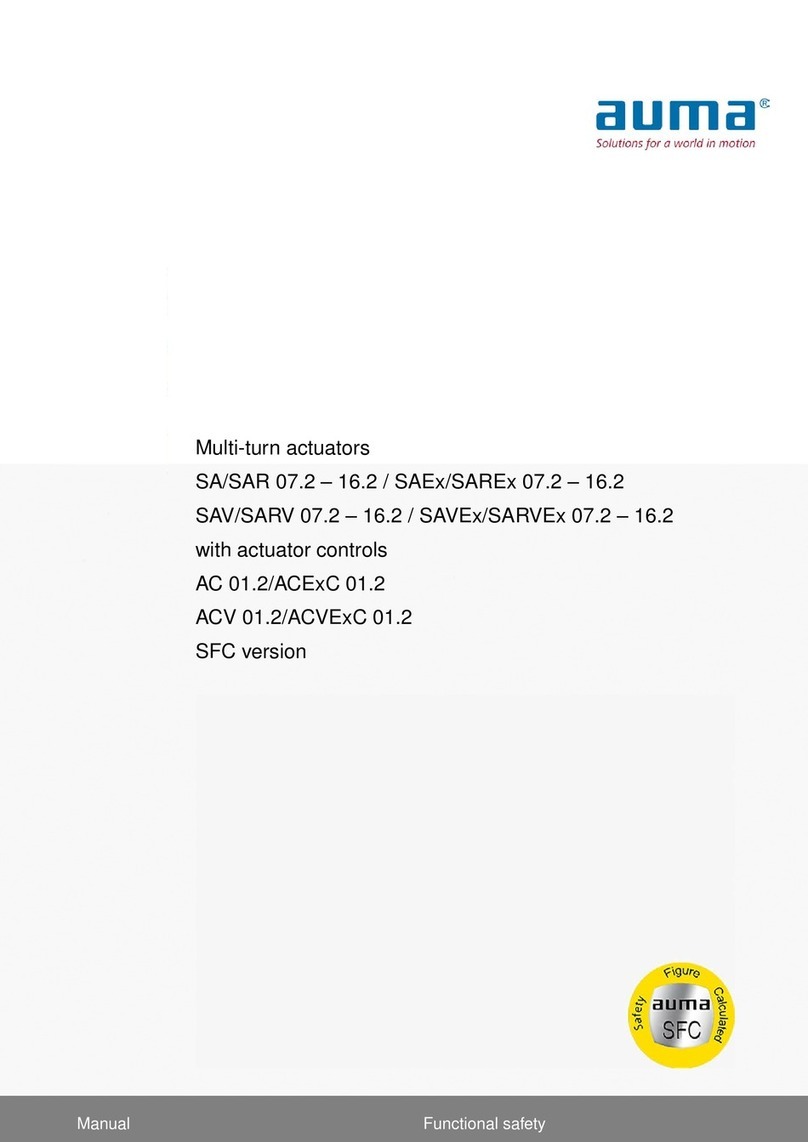
AUMA
AUMA SA 07.2 User manual
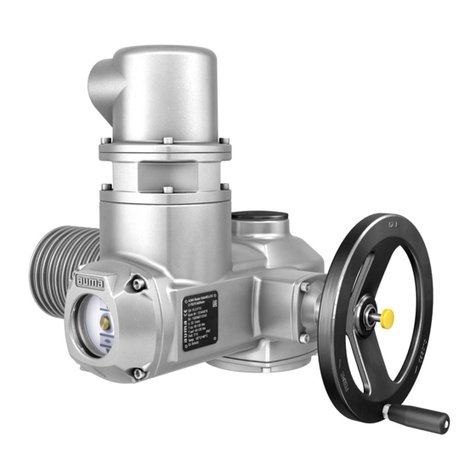
AUMA
AUMA SAREx 07.2 - SAREx 16.2 User manual
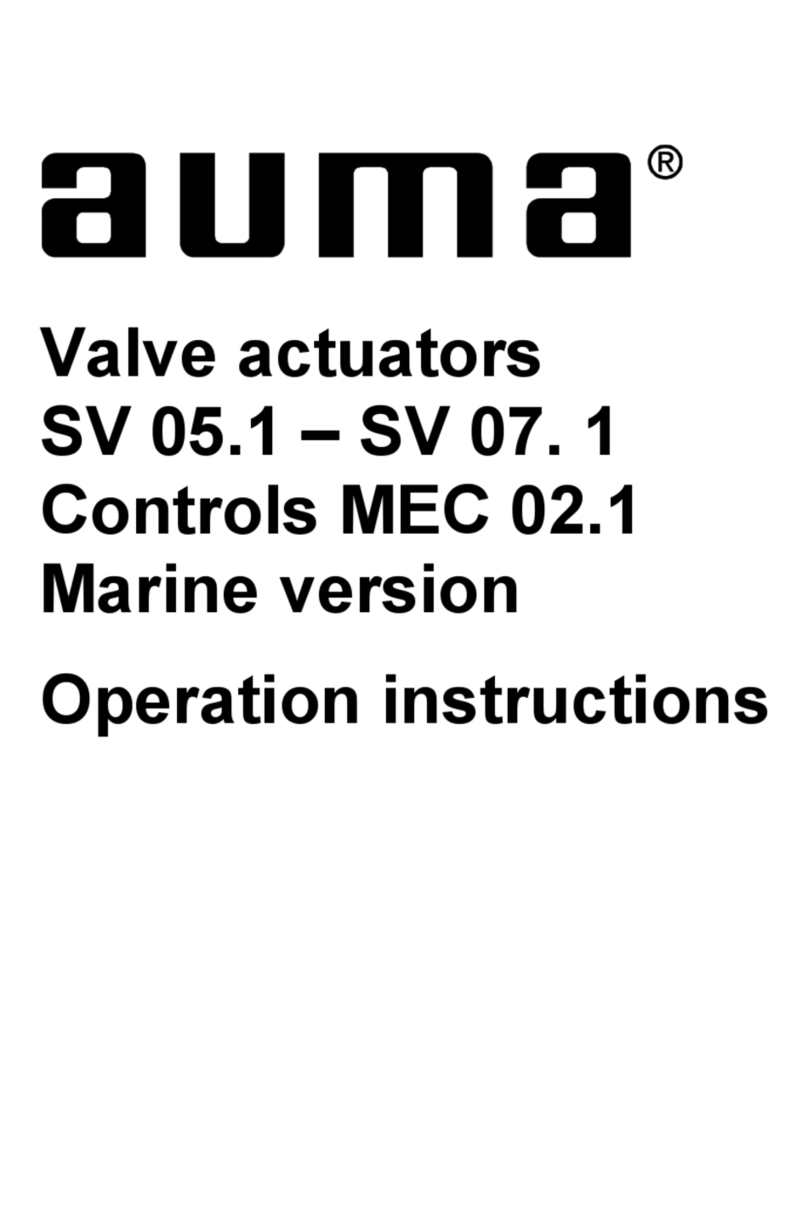
AUMA
AUMA SV 05.1 User manual
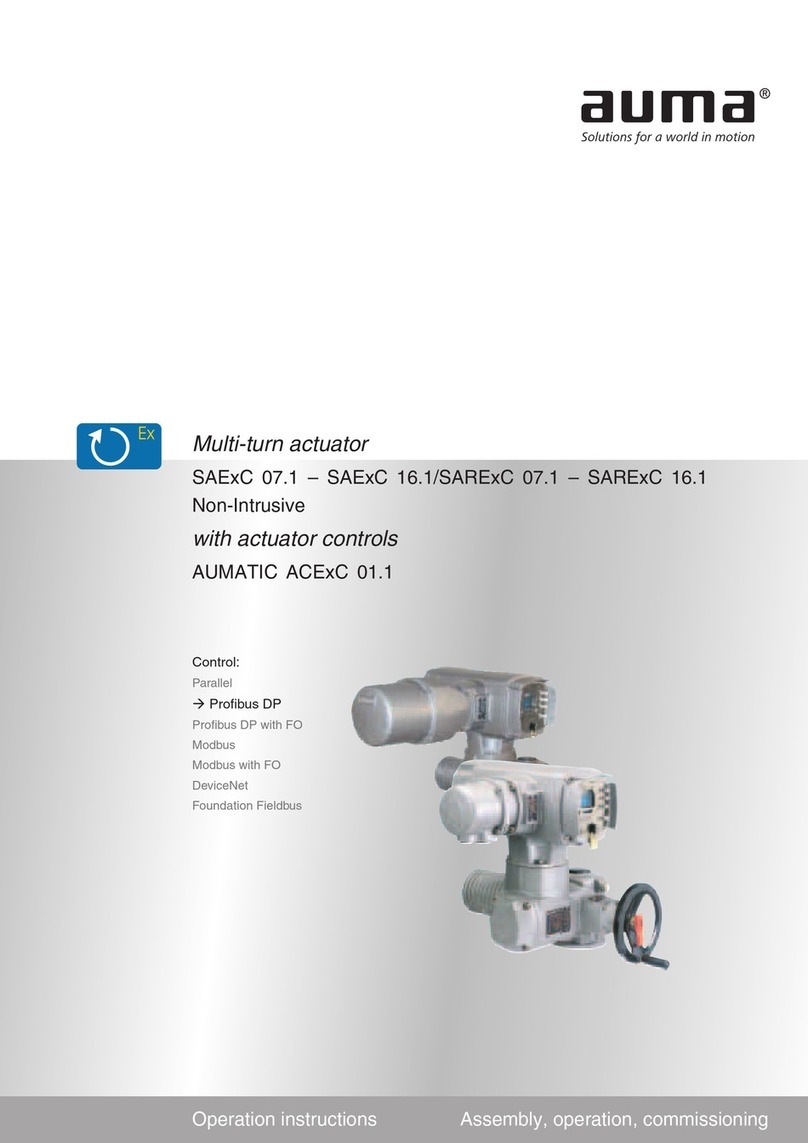
AUMA
AUMA SAExC 07.1 User manual
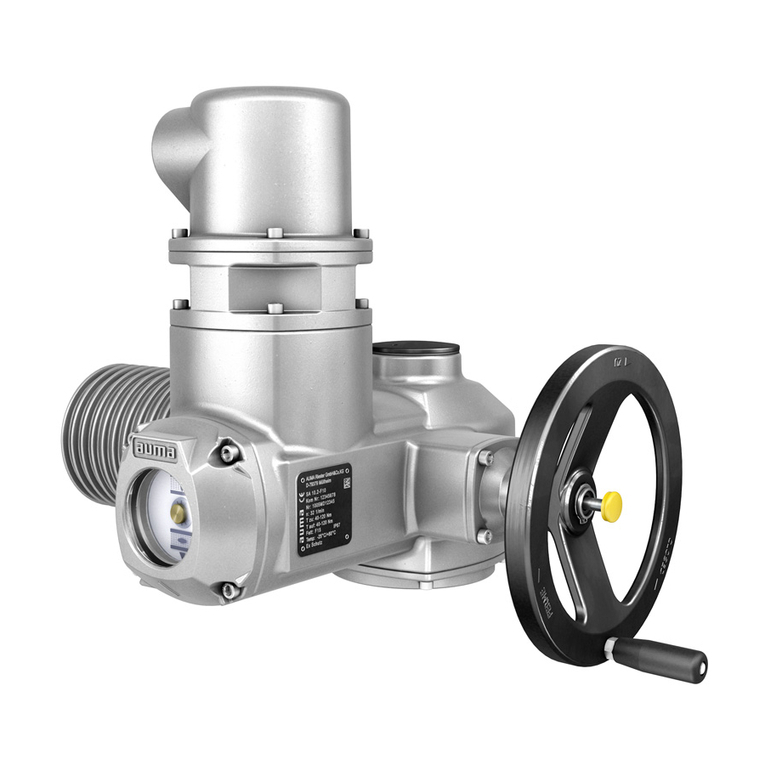
AUMA
AUMA SAEx 07.2 User manual
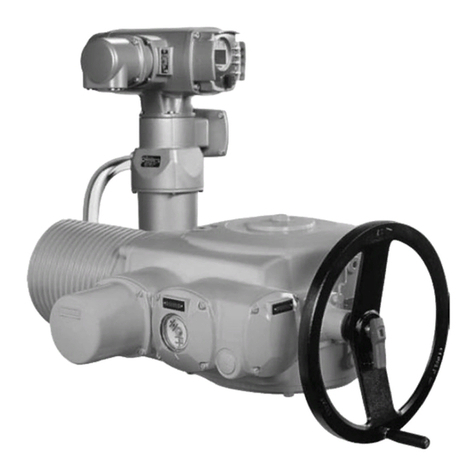
AUMA
AUMA SAEx 25.1 User manual
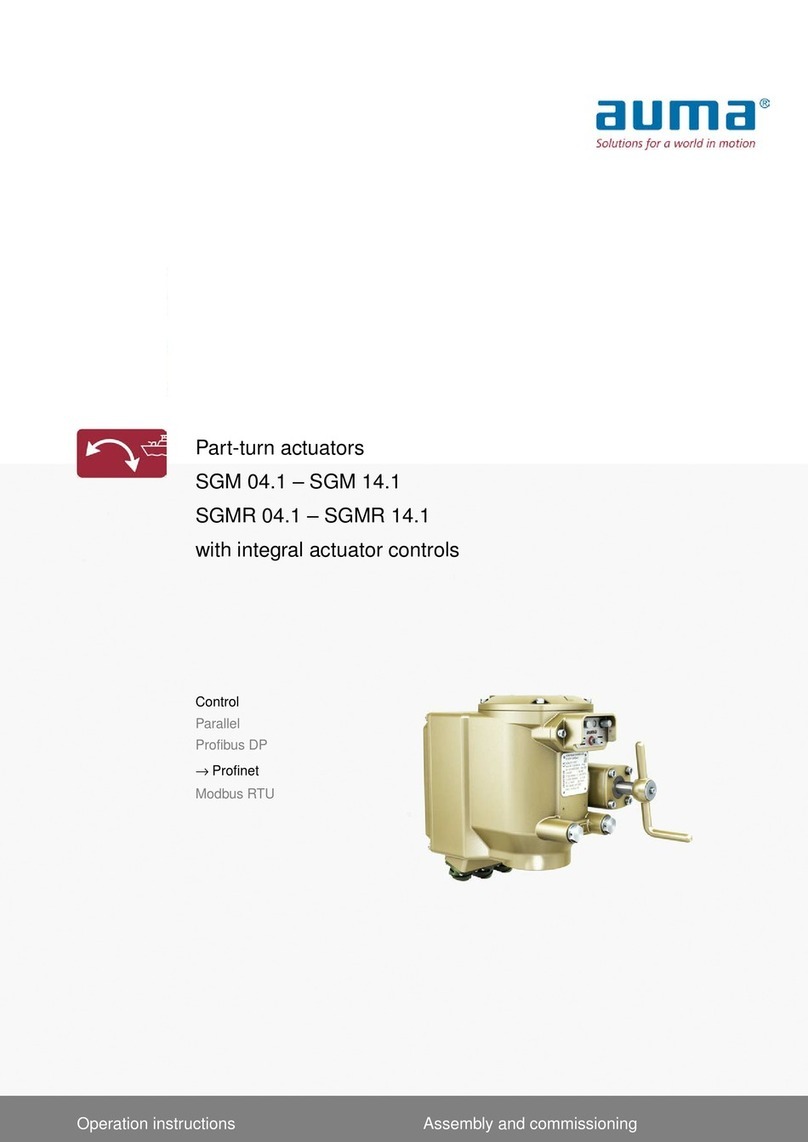
AUMA
AUMA SGM 04.1 User manual
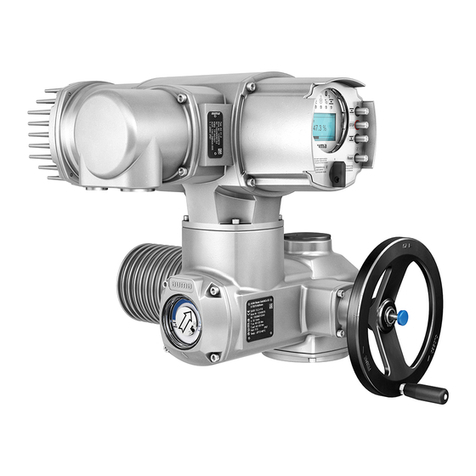
AUMA
AUMA SAV 07.2 User manual
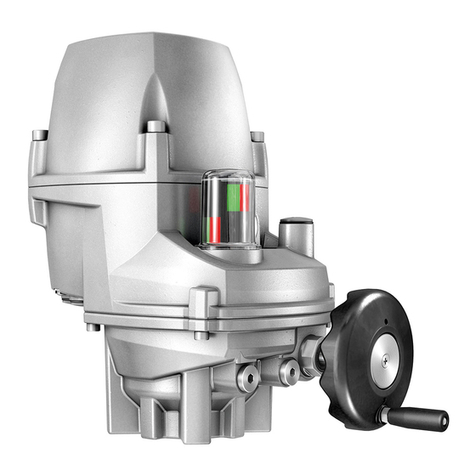
AUMA
AUMA PROFOX PF-Q80 User manual
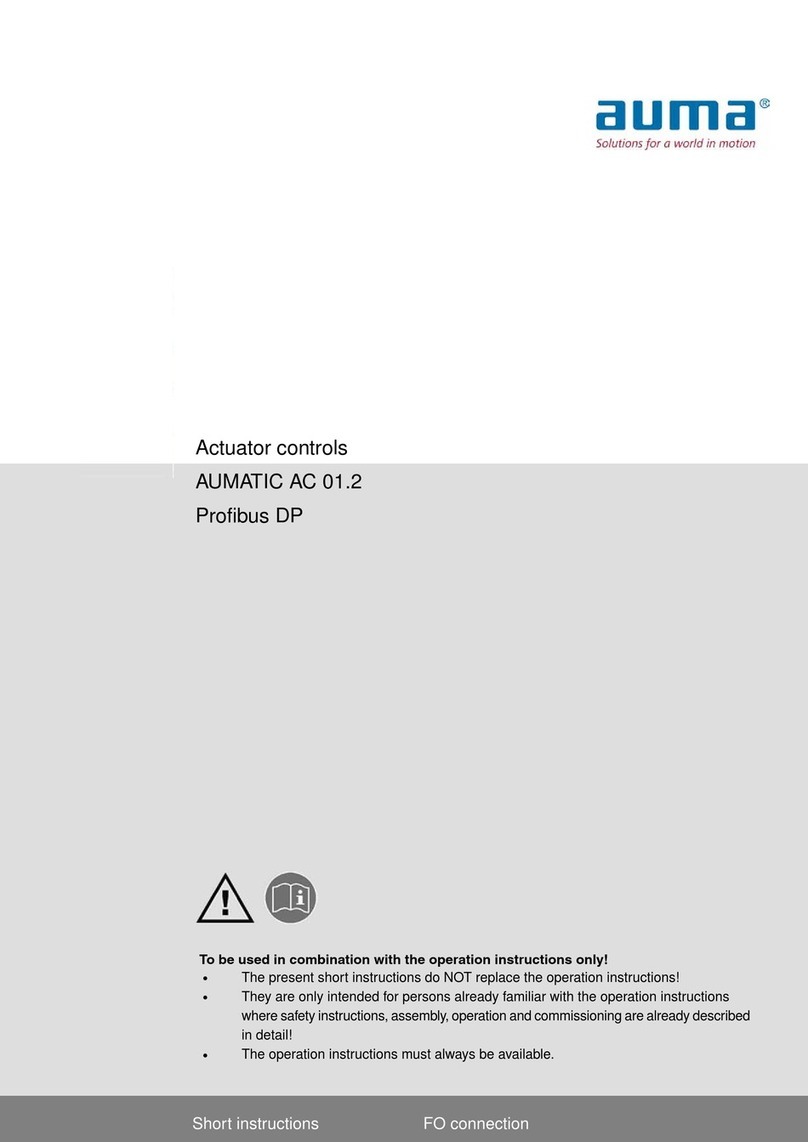
AUMA
AUMA AUMATIC AC 01.2 Manual
